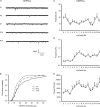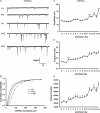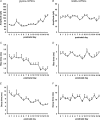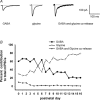Excitatory-inhibitory imbalance in hypoglossal neurons during the critical period of postnatal development in the rat
- PMID: 21486774
- PMCID: PMC3090599
- DOI: 10.1113/jphysiol.2010.198945
Excitatory-inhibitory imbalance in hypoglossal neurons during the critical period of postnatal development in the rat
Abstract
Hypoglossal motoneurons (HMs) innervate tongue muscles and are critical in maintaining patency of the upper airway during respiration. Abnormalities in HMs have been implicated in sudden infant death syndrome (SIDS) and obstructive sleep apnoea. Previously, we found a critical period in respiratory network development in rats around postnatal day (P) 12-13, when abrupt neurochemical, metabolic and physiological changes occurred. To test our hypothesis that an imbalance between inhibitory and excitatory synaptic transmission exists during the critical period, whole-cell patch-clamp recordings of HMs were done in brainstem slices of rats daily from P0 to P16. The results indicated that: (1) the amplitude and charge transfer of miniature excitatory postsynaptic currents (mEPSCs) were significantly reduced at P12-13; (2) the amplitude, mean frequency and charge transfer of miniature inhibitory postsynaptic currents (mIPSCs) were significantly increased at P12-13; (3) the kinetics (rise time and decay time) of both mEPSCs and mIPSCs accelerated with age; (4) the amplitude and frequency of spontaneous EPSCs were significantly reduced at P12-13, whereas those of spontaneous IPSCs were significantly increased at P12-13; and (5) both glycine and GABA contributed to mIPSCs. However, GABAergic currents fluctuated within a narrow range during the first three postnatal weeks, whereas glycinergic ones exhibited age-dependent changes comparable to those of total mIPSCs, indicating a reversal in dominance from GABA to glycine with development. Thus, our results provide strong electrophysiological evidence for an excitatory-inhibitory imbalance in HMs during the critical period of postnatal development in rats that may have significant implications for SIDS.
Figures








Similar articles
-
Reduced levels of brain-derived neurotrophic factor contribute to synaptic imbalance during the critical period of respiratory development in rats.Eur J Neurosci. 2014 Jul;40(1):2183-95. doi: 10.1111/ejn.12568. Epub 2014 Mar 26. Eur J Neurosci. 2014. PMID: 24666389 Free PMC article.
-
The nonuniform distribution of the GABA(A) receptor alpha 1 subunit influences inhibitory synaptic transmission to motoneurons within a motor nucleus.J Neurosci. 2001 Nov 1;21(21):8482-94. doi: 10.1523/JNEUROSCI.21-21-08482.2001. J Neurosci. 2001. PMID: 11606637 Free PMC article.
-
Contribution of single-channel properties to the time course and amplitude variance of quantal glycine currents recorded in rat motoneurons.J Neurophysiol. 1999 Apr;81(4):1608-16. doi: 10.1152/jn.1999.81.4.1608. J Neurophysiol. 1999. PMID: 10200197
-
Development of inhibitory synaptic transmission to motoneurons.Brain Res Bull. 2000 Nov 15;53(5):553-60. doi: 10.1016/s0361-9230(00)00389-0. Brain Res Bull. 2000. PMID: 11165791 Review.
-
Development of synaptic transmission to respiratory motoneurons.Respir Physiol Neurobiol. 2011 Oct 15;179(1):34-42. doi: 10.1016/j.resp.2011.03.002. Epub 2011 Mar 5. Respir Physiol Neurobiol. 2011. PMID: 21382524 Free PMC article. Review.
Cited by
-
Treadmill Exercise Reduces Neuroinflammation, Glial Cell Activation and Improves Synaptic Transmission in the Prefrontal Cortex in 3 × Tg-AD Mice.Int J Mol Sci. 2022 Oct 21;23(20):12655. doi: 10.3390/ijms232012655. Int J Mol Sci. 2022. PMID: 36293516 Free PMC article.
-
Chronic central serotonin depletion attenuates ventilation and body temperature in young but not adult Tph2 knockout rats.J Appl Physiol (1985). 2016 May 1;120(9):1070-81. doi: 10.1152/japplphysiol.01015.2015. Epub 2016 Feb 11. J Appl Physiol (1985). 2016. PMID: 26869713 Free PMC article.
-
Abrupt changes in pentobarbital sensitivity in preBötzinger complex region, hypoglossal motor nucleus, nucleus tractus solitarius, and cortex during rat transitional period (P10-P15).Respir Physiol Neurobiol. 2015 Feb 1;207:61-71. doi: 10.1016/j.resp.2014.12.016. Epub 2014 Dec 27. Respir Physiol Neurobiol. 2015. PMID: 25550216 Free PMC article.
-
Mortality and ventilatory effects of central serotonin deficiency during postnatal development depend on age but not sex.Physiol Rep. 2021 Jul;9(13):e14946. doi: 10.14814/phy2.14946. Physiol Rep. 2021. PMID: 34228894 Free PMC article.
-
Reduced levels of brain-derived neurotrophic factor contribute to synaptic imbalance during the critical period of respiratory development in rats.Eur J Neurosci. 2014 Jul;40(1):2183-95. doi: 10.1111/ejn.12568. Epub 2014 Mar 26. Eur J Neurosci. 2014. PMID: 24666389 Free PMC article.
References
-
- Aldes LD, Chapman ME, Chronister RB, Haycock JW. Sources of noradrenergic afferents to the hypoglossal nucleus in the rat. Brain Res Bull. 1992;29:931–942. - PubMed
-
- Ballanyi K. Neuromodulation of the perinatal respiratory network. Curr Neuropharm. 2004;2:221–243. - PubMed
-
- Bekkers JM, Stevens CF. Presynaptic mechanism for long-term potentiation in the hippocampus. Nature. 1990;346:724–729. - PubMed
-
- Berger AJ, Bayliss DA, Viana F. Development of hypoglossal motoneurons. J Appl Physiol. 1996;81:1039–1048. - PubMed
-
- Burgard EC, Hablitz JJ. NMDA receptor-mediated components of miniature excitatory synaptic currents in developing rat neocortex. J Neurophysiol. 1993;70:1841–1852. - PubMed
Publication types
MeSH terms
Substances
Grants and funding
LinkOut - more resources
Full Text Sources

